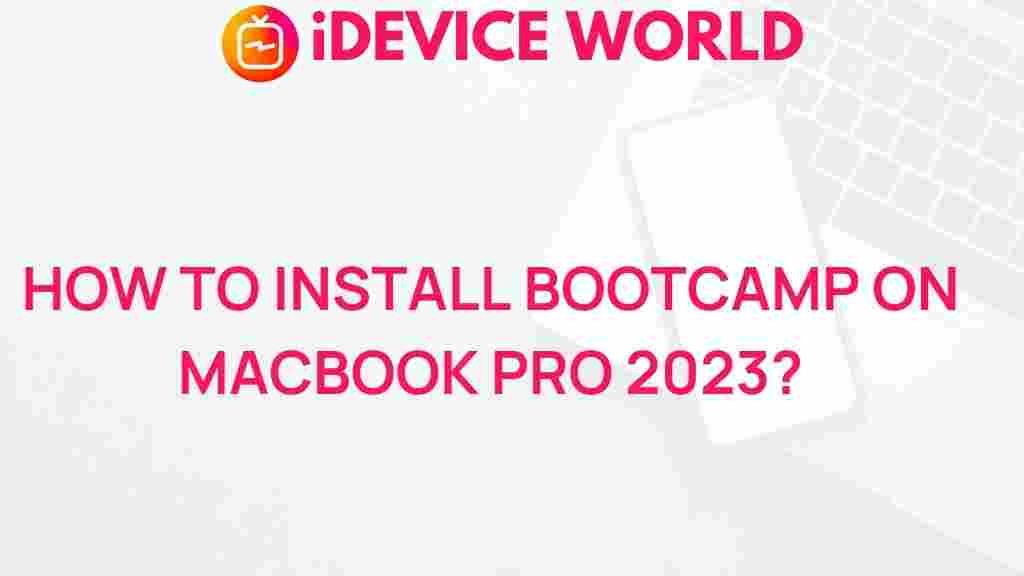Unleash the Power: Installing Bootcamp on MacBook Pro 2023
In the world of computing, flexibility is key. For many Mac users, the ability to run Windows applications seamlessly can enhance productivity and broaden functionality. One of the most effective ways to achieve this on a MacBook Pro is through Bootcamp, a built-in utility that allows you to install and run Windows alongside macOS. This guide will walk you through the process of installing Bootcamp on your MacBook Pro 2023, ensuring you maximize your device’s potential.
What is Bootcamp?
Bootcamp is a dual-boot utility included with macOS, designed to help users install Windows on their Mac devices. This allows users to run Windows applications natively, providing optimal performance without the overhead of virtualization. For professionals and gamers alike, Bootcamp presents a powerful solution for leveraging both operating systems on a single machine.
Why Choose Bootcamp for Your MacBook Pro?
- Performance: Since Bootcamp runs Windows natively, it uses your Mac’s hardware to its full potential.
- Compatibility: Many applications, especially those related to gaming and professional software, are designed primarily for Windows.
- Ease of Use: The Bootcamp installation process is straightforward, making it accessible for users with varying technical skills.
Step-by-Step Guide to Installing Bootcamp
Step 1: Check Your System Requirements
Before you begin, ensure your MacBook Pro meets the following requirements:
- macOS Version: Ensure you are running the latest version of macOS.
- Storage Space: You will need sufficient free storage space for the Windows installation (at least 64GB is recommended).
- Backup Your Data: Always back up your important files using Time Machine or another backup solution.
Step 2: Download Windows ISO File
The next step is to download the Windows ISO file:
- Visit the official Microsoft website.
- Choose the version of Windows you wish to install (Windows 10 or 11 is recommended).
- Download the ISO file and save it to your Mac.
Step 3: Open Bootcamp Assistant
Now, you will use Bootcamp Assistant to set up your Windows partition:
- Open the Finder and navigate to Applications > Utilities.
- Launch Bootcamp Assistant.
- Click Continue to proceed.
Step 4: Partition Your Disk
Bootcamp Assistant will guide you through partitioning your disk:
- Select the Windows ISO file you downloaded earlier.
- Allocate space for Windows. You can choose from various partition sizes based on your needs.
- Click Install to begin the partitioning process.
Step 5: Install Windows
Once the partition is set, your Mac will restart, and the Windows installation will begin:
- Select your language and preferences, then click Next.
- Accept the license terms and click Next again.
- Select the Bootcamp partition and format it. Choose NTFS as the file system, then click Next.
- Follow the on-screen instructions to complete the Windows installation.
Step 6: Install Bootcamp Drivers
After Windows installation is complete, you need to install the Bootcamp drivers to ensure proper hardware functionality:
- Once Windows boots up, insert your USB drive containing the Bootcamp drivers.
- Run the setup.exe file from the USB drive.
- Follow the installation prompts to install the drivers.
Step 7: Restart Your Mac
After the drivers have been installed, restart your MacBook Pro. You can switch between macOS and Windows by holding down the Option (Alt) key during startup and selecting your desired operating system.
Troubleshooting Bootcamp Installation Issues
Even with a straightforward installation process, issues may arise. Here are some common problems and their solutions:
Problem 1: Bootcamp Assistant Won’t Launch
If Bootcamp Assistant fails to open, try the following:
- Ensure your macOS is up to date.
- Restart your Mac and try again.
- Check if your Mac’s hardware is compatible with Bootcamp.
Problem 2: Windows Fails to Install
If Windows fails to install, consider these solutions:
- Re-download the Windows ISO file to ensure it’s not corrupted.
- Make sure your hard drive has enough free space for the Windows installation.
- Try using a different USB drive for the Bootcamp drivers.
Problem 3: Missing Bootcamp Drivers
If you experience hardware issues or missing drivers after installation:
- Re-insert the USB drive containing the Bootcamp drivers and run the setup again.
- Visit the official Apple Support page for the latest drivers.
- Check Device Manager in Windows to identify any missing drivers.
Maximizing Your Bootcamp Experience
Now that you have successfully installed Bootcamp, here are some tips to enhance your experience:
- Regular Updates: Keep both macOS and Windows updated for security and performance enhancements.
- Utilize Disk Space Wisely: Regularly check and manage your disk space on both partitions to avoid performance issues.
- Backup Your Data: Regular backups are essential to prevent data loss in case of system failures.
Conclusion
Installing Bootcamp on your MacBook Pro 2023 opens up a world of possibilities, allowing you to leverage both macOS and Windows. By following the steps outlined in this guide, you can seamlessly integrate Windows into your workflow, enhancing your productivity and gaming experience. Remember to troubleshoot any issues that may arise and keep both operating systems updated to ensure optimal performance.
For more information on enhancing your Mac experience, check out our comprehensive guide on macOS tips. If you encounter persistent issues, consider reaching out to Apple Support for assistance. Happy computing!
This article is in the category Guides & Tutorials and created by iDeciveWorld Team
